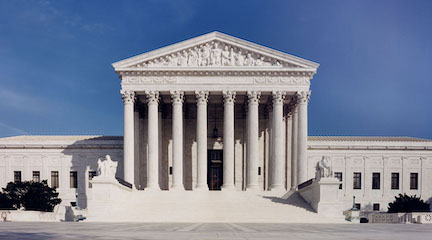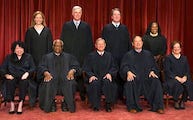 |
A Vacancy on the Court | < |
Issues and ControversiesThis page addresses specific issues and controversies regarding the nomination and confirmation process. Contributions and comments are invited. Send to Professor George Watson.
Deference to the President? I don’t think so.The president’s nomination of one to the Supreme Court inevitably is accompanied by claims that deference should be given his choice, an argument usually espoused by members of the president’s party. That argument takes on more legitimacy when a source as prominent as the Washington Post editorializes “if the presidential election means anything . . . it [is] that the president's choice has a heavy presumption of confirmation. That is the way the system works. Why else would Justices Sandra Day O'Connor, Antonin Scalia, Stephen G. Breyer and Ruth Bader Ginsburg have received only a handful of no-votes among them?” But that is not the way the system works. The notion of an electoral mandate for a president regarding specific policies or appointments to the Supreme Court is a myth. The closest we come to electoral mandates in this nation is in initiative and referendum voting. Supreme Court nominations are not Cabinet appointments, not even just another judicial appointment. The justices head the essential third branch of our government. It is they who give life to equal protection for all and who define the powers and limitations on those powers granted by our Constitution. The framers, stymied by the best way to appoint the federal judiciary, compromised by saying only that the president, by and with the consent of the Senate, shall appoint. George Washington immediately saw the appropriate execution of this terse dictate. He would appoint whomever he wished and the Senate could make its own independent assessment regarding whether to consent. Neither had to give reasons for their judgments, although the need for persuasion would recommend doing so. Whether or not there actually is a presumption in favor of the president’s nominee depends entirely on the potential for controversy inherent in the vacancy setting and on how the president addresses that potential. The four appointments mentioned above received a handful of “No” votes, not because of a “heavy presumption” in favor of the president’s choice, but for other reasons. In the case of O’Connor, Reagan nominated a relative unknown who was viewed as better than the Democrats’ worst fears, and they could hardly oppose the first female nominee to the Court. In the case of Scalia, the simultaneous nomination of Rehnquist to be Chief Justice resulted in a strategic decision of Democrats to focus opposition on Rehnquist, not Scalia. Indeed, had Reagan nominated Robert Bork rather than Scalia, there is little doubt that Bork would now be on the Court. Breyer and Ginsburg are both instances of President Clinton appointing someone distinctly less liberal and more palatable to the Republicans than might otherwise have been the case. These nominations also occurred in settings in which the potential for controversy was relatively low. Controversy in Supreme Court nominations has everything to do with the context in which nominations occur. When Reagan appointed Bork, the potential for controversy was considerable. The Democrats had regained control of the Senate, Reagan’s approval ratings had dropped to around 50%, 15 points lower than when Scalia had been nominated, and the vacancy was that of Lewis Powell, the quintessential swing vote in numerous 5-4 Court decisions. Reagan responded to this potential for controversy by nominating Bork, the equivalent of tossing gasoline on a smoldering fire. Today the vacancy is O’Connor, not only the key swing vote in crucial 5-4 decisions but one of only two women on the Court. Bush’s approval rating is 5 to 10% points lower than that Reagan faced. And while the Republicans control the Senate by a comfortable 10 vote margin, the potential for controversy here is considerable. Posted 6 October 2005 Myth of the Up or Down Simple Majority VoteMyths abound in American politics—false claims that are put forward for partisan gain under the guise of constitutional or moral legitimacy. Among them are the myth of the electoral mandate, the myth of original intent, and the myth of the will of the American people. The recent Supreme Court nominations from President Bush have been accompanied by an attempt to construct a new reality: the mandate of an up or down simple majority vote on Supreme Court nominees. There are two parts to this emerging construction: that there be an up or down vote and that such a vote must be governed by a simple majority of those voting. Any claim that the Constitution or at least political tradition requires the Senate to conduct an up or down vote on whether to confirm a Supreme Court nominee is false. The relevant paragraph of the Constitution is Article II Section 2: He (the president) shall have Power, by and with the Advice and Consent of the Senate, to make Treaties, provided two thirds of the Senators present concur; and he shall nominate, and by and with the Advice and Consent of the Senate, shall appoint Ambassadors, other public Ministers and Consuls, Judges of the supreme Court, and all other Officers of the United States, whose Appointments are not herein otherwise provided for, and which shall be established by Law . . . Whether one adopts an interpretative stance of plain meaning, original intent, or historical precedence, the argument that an up or down vote on Supreme Court nominees is required cannot be justified. While Section 2 clearly indicates that the consent of the Senate is required for a Supreme Court judge to be appointed, the failure to give that consent can occur in a number of ways: through a specific vote on the confirmation question, as with the nominations of Robert Bork, Harold Carswell, and Clement Haynsworth, or by not bringing the issue of consent to a vote at all. Historically, avoiding an up or down vote on confirmation has happened in three
ways. Most common has been postponing consideration of the issue, a technique
easily used by the Senate majority, which controls the flow of business. Nominations
submitted have languished by the failure to consider them, a consideration which
lies with the leadership of the Senate majority and which has occurred no fewer
than 10 times in Supreme Court nominations. This scenario is most common when
a president’s opponents control the Senate, as with Senate Republicans during
the Clinton administration and Democrats during a portion of the senior Bush presidency. Finally, a direct vote on whether to give consent has been avoided through the instigation of a filibuster, unlimited debate designed to keep an issue from coming to the floor of the Senate for a vote. Whereas postponement is a tool of the majority, the filibuster is an instrument by which a minority in the Senate can register its strong opposition regarding an issue, effectively forcing a super majority of 60 to shut off debate and permit the issue to come to a vote. In Supreme Court nominations, it has been used only once, in 1968 by a coalition of Republicans and conservative Southern Democrats to forestall a vote on President Johnson’s nomination of Abe Fortas to be Chief Justice of the United States. At that time 67 votes were required to shut off debate and the vote of 45 to 43 in favor of closing debate fell well short of that requirement. Despite partisan efforts to claim either that this was not a filibuster or that it was not a scenario in which a majority favored the nominee, certainly the thinking at that time was that a straight up or down vote on Fortas would have confirmed his nomination. The vote itself suggests that and the fact that opponents felt it necessary to filibuster rather than permit an up or down vote also suggests that. Regardless, the action was a filibuster, permitted to operate as a filibuster, and no effort was made to circumvent the traditional operation of a filibuster or say it could not be employed in a Supreme Court nomination. Of those three methods to prevent a consent vote, only the filibuster nonetheless provides an opportunity to vote on the nomination, albeit forcing a super majority (viz., 60 among the 100 senators) to accomplish confirmation. That may be a reasonable criterion for appointments to lifetime positions. Clearly, super majority approval of Court nominees was not required by the framers of the Constitution. Had they intended to do so, they would have made it explicit, as they did in the first part of Article II Section 2 regarding treaties. However, to assert that the Constitution mandates approval by a simple majority of those voting is also unjustified. The Constitution is simply silent on the matter, as it is about so much of the operation of Congress. Approval by a simple majority is merely the way the Senate has operated when voting on issues except where it has established specific rules to the contrary, as with the filibuster. To suggest that Supreme Court nominations cannot be filibustered has no constitutional foundation nor historical precedent. In the current setting of the Alito nomination, supporters have opined that judicial nominations should be free from partisan rancor and decried the strong opposition expressed by the minority as partisan rhetoric. But partisan nominations evoke partisan responses. It is the president who determines whether a nomination will stir controversy. Presidents Johnson and Reagan opted for the politics of controversy in nominating Fortas and Bork, respectively. Presidents Hoover and Ford chose the politics of consensus in nominating Cardozo and Stevens. President Bush elected for the politics of controversy, unintentionally with the nomination of Miers who was surprisingly doomed by the president’s own partisans, and then with Alito who pacified those same partisans clamoring for a known strong conservative while aggravating and activating those on the left seeking a more centrist nominee. The only way to turn controversial nominations into more civil affairs is to appoint nominees who can command a super majority in the Senate. Nominees lacking support from three-fifths of the Senate are controversial, through no fault of their own, but by the circumstances of the vacancy and the political setting in which they have been placed. The filibuster provides an appropriate mechanism by which the Senate and the American people can be reassured through a 60-vote consensus that this nominee is right for this vacancy at this particular point in time. Were I a senator, I would filibuster every Supreme Court nomination in order to secure justices that have the support of at least three-fifths of the senators. Posted 27 January 2005 |